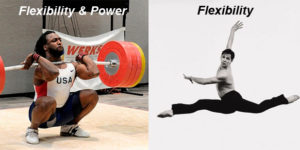 Before we dive straight into flexibility and the high velocity pitcher we need to first define what flexibility is and why is it so important to the high velocity pitcher. Conventional wisdom has this flexibility issue completely wrong. How many times have you heard your coach or a coach say that working out makes you tight and you need to be more flexible, but at the same time he is complaining that you do not throw hard enough? This should tell you that this is a coach who has a very poor understanding of the body and especially the high velocity pitcher.
Before we dive straight into flexibility and the high velocity pitcher we need to first define what flexibility is and why is it so important to the high velocity pitcher. Conventional wisdom has this flexibility issue completely wrong. How many times have you heard your coach or a coach say that working out makes you tight and you need to be more flexible, but at the same time he is complaining that you do not throw hard enough? This should tell you that this is a coach who has a very poor understanding of the body and especially the high velocity pitcher.
Flexibility is the common word used to define a limber body that can easily bend and stretch, the problem is this doesn't really define the high velocity pitcher. The high velocity pitcher does a lot more than just bend and stretch his body, he also generates power. If a high velocity pitcher is just bending and stretching but not generating power in return, then we do not have a high velocity pitcher. The question you should ask your coach is do you want me to just be flexible or do you want me to be both flexible and powerful like a high velocity pitcher? The picture above should prove your point.
Flexibility + Power = High Velocity Pitcher
Let's look even deeper into the flexibility of the high velocity pitcher to discover how flexibility and power production work together. When a pitcher is bending or stretching his body, his bones are pulling on his tendons and muscles. Tendons and muscles are very similar to the properties of a rubber band. They are elastic, so when bending and stretching the body, it creates elastic energy by stretching the muscles like rubber bands. Science has also defined this elastic force multiplier in the musculature of the body as the Stretch Shortening Cycle (SSC). The SSC proves that a muscle will enhance performance and generate more power when first stretched before it is fired or when an eccentric contraction comes before the concentric contraction. This is why high velocity pitchers bend and stretch their bodies before they generate massive amounts of power.
In each joint that is being stretched to fire you have two muscles acting on one another. These muscles are called the agonist and the antagonist. The agonist is the muscle and tendon that is pulling on the bone to extend the joint. In the case of the knee, it would be the quadriceps muscle. The antagonist is the muscle that is being pulled on in opposition and therefore is being stretched. In the case of the extending knee it would be the hamstring muscles and tendons that are being stretched. Flexibility for the high velocity pitcher has everything to do with the strength of the agonist muscle and also the strength of the antagonist muscle. To flex and move the joint through a full range of motion, it takes the strength of the agonist muscle to pull the antagonist muscle to its max while the strength of the antagonist muscle is important to prevent the muscle from pulling apart during this stretch. This means that a lack of strength and strength of elasticity will reduce flexibility and pitching velocity.
If you are a stocky or lanky pitcher it doesn't matter, you both need to be strong and flexible. You have to have the ability to stretch and fire the muscles to enhance power and increase pitching velocity. Stockier pitchers, like a short and thick rubber band, do not have to stretch as far as the lanky pitcher, like a long and skinning rubber band, to generate the same power but the stockier pitcher has to pull back harder than the lanky pitcher who has to pull back farther than the stockier pitcher. This is why lanky high velocity pitchers have more hip to shoulder separation and external rotation than stocky pitchers.
The best way to improve this flexibility and power production at the same time is using heavy loads with low reps through a full range of motion. This type of strength training will increase flexibility and at the same time increase strength because of the low reps. Higher reps can cause more hypertrophy, which can grow the muscle bigger but not necessarily that much stronger, this can work against flexibility. The strength developed through low reps and full range of motion will have the potential to generate more power production as well. You can learn more about the science behind this in the recent article called, How To Develop Extreme 3X Power To Increase Pitching Velocity.
The Science of Flexibility and Strength Training
There are several case studies listed below that support the scientific fact that strength training can improve flexibility. In many cases some type of flexibility training along with the strength training is more beneficial.
The influence of strength, flexibility, and simultaneous training on flexibility and strength gains.
Simão R, Lemos A, Salles B, Leite T, Oliveira É, Rhea M, Reis VM. - Federal University of Rio de Janeiro, Physical Education Post-Graduation Program, Rio de Janeiro, Brazil. - J Strength Cond Res. 2011 May;25(5):1333-8.
In conclusion, short-term strength training increases flexibility and strength in sedentary adult women. Strength training may contribute to the development and maintenance of flexibility even without the inclusion of additional stretching, but strength and flexibility can be prescribed together to get optimal improvements in flexibility.
Read the entire study here: http://www.ncbi.nlm.nih.gov/pubmed/21386731
Resistance training vs. static stretching: effects on flexibility and strength.
Morton SK, Whitehead JR, Brinkert RH, Caine DJ. - Department of Physical Education, Exercise Science, and Wellness (PXW), University of North Dakota, Grand Forks, North Dakota, USA. - J Strength Cond Res. 2011 Dec;25(12):3391-8.
The results of this preliminary study suggest that carefully constructed full-range RT regimens can improve flexibility as well as the typical SS regimens employed in conditioning programs. Because of the potential practical significance of these results to strength and conditioning programs, further studies using true experimental designs, larger sample sizes, and longer training durations should be conducted with the aim of confirming or disproving these results.
Read the entire study here: http://www.ncbi.nlm.nih.gov/pubmed/21969080
A Comparison of the Immediate Effects of Eccentric Training vs Static Stretch on Hamstring Flexibility in High School and College Athletes
Russell T. Nelson, PT, PhD, SCS, ATC - N Am J Sports Physical Therapy. 2006 May; 1(2): 56–61.
Results:
A significant difference was indicated by follow up analysis between the control group (gain = -1.08°) and both the static stretch (gain = 5.05°) and the eccentric training group (gain = 9.48°). In addition, the gains in the eccentric training group were significantly greater than the static stretch group.
Discussion and Conclusion:
The findings of this study reveal that one session of eccentrically training through a full range of motion improved hamstring flexibility better than the gains made by a static stretch group or a control group.
Read the entire study here:http://www.ncbi.nlm.nih.gov/pmc/articles/PMC2953312/
The final case study below proves that not only will strength training improve flexibility but ballistic power training and heavy strength training is critical for enhancing the SSC. It proved that the enhanced force production from strength and power training created a greater unloading following the eccentric phase of a movement which increased velocity. We know that through New's Second Law of Motion that more range of motion or flexibility coupled with greater force production equals increased acceleration or velocity.
Changes in the eccentric phase contribute to improved stretch-shorten cycle performance after training.
Russell T. Nelson, PT, PhD, SCS, ATC - N Am J Sports Phys Ther. 2006 May; 1(2): 56–61.
Results:
Both power and strength training elicited significant changes in a multitude of eccentric (ECC) variables that were significantly associated with improvements in concentric (CON) performance. Enhancements in CON performance were theorized to be driven by the development of a strategy to better use the ECC phase during jumping (i.e., greater unloading allowed for increased negative acceleration and thus velocity during the countermovement and improved musculotendinous stiffness resulted in an enhanced ability to translate the momentum developed during the ECC phase into force). Although a significant improvement in maximal strength resulted in changes to SSC function during the ECC phase, the initial strength level did not significantly affect the ECC variables before training or the magnitude of adaptations in individuals exposed to ballistic power training.
Conclusion:
Training-induced alterations in SSC function during the ECC phase contributes to improvements in jump performance after both ballistic power training and heavy strength training.
Read the entire study here:http://www.ncbi.nlm.nih.gov/pubmed/20142784
6 Steps to Improving Flexibility & Power for the Pitcher
We have learned here that strength training isn't what the conventional wisdom of the game tries to make it out to be. It can actually improve flexibility. We may never educate these conventional coaches on this information but we can at least educate ourselves and benefit from the results. We also learned that it is best to use some type of flexibility training and strength or power training through a full range of motion if we want to improve flexibility and power production. If you are in a strength training program and you do not train through a full range of motion or use any flexibility training to go with it, then you could actually be tightening up and losing flexibility and power production. The answer is not to quit strength training all together, that would be throwing the baby out with the bath water, the answer would be to learn how to follow the case studies above and the steps listed below. Here are those 6 steps to improving flexibility for the pitcher.
Strength and Power Training to Improve Flexibility and Power Production
- Pre-game or pre-workout start with a soft tissue program if needed to reduce muscle density.
- Pre-game or pre-workout always start with a dynamic warm-up to raise body temperature and stretch your muscles through a gradual progression.
- When squatting or pulling always lift with a full range of motion to build strength through this full range.
- Perform resistance movements through a similar range of motion as when you are pitching to make sure your strength is sport or even position specific.
- Post-game or post-workout use static stretching if necessary to help elongate the muscle as you cool down.
- Stay very active in your days. DO NOT SIT IN ONCE PLACE FOR A LONG TIME, ESPECIALLY FOLLOWING A WORKOUT.
All of the routines and programs listed above can be found in the 3X Pitching Velocity Program.




Ha! That’s exactly why I never stretched when I was younger! I thought of that sissy guy on the right or Jane Fonda’s hip squeeze deal or Richard Simmons. Thanks for the article, always great stuff. Opens our eyes.